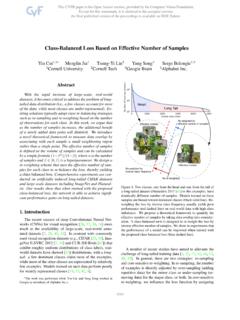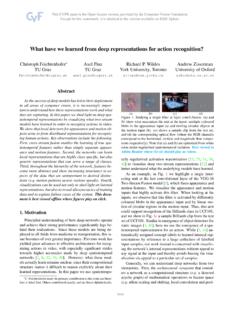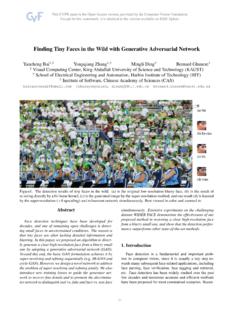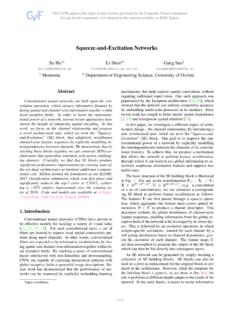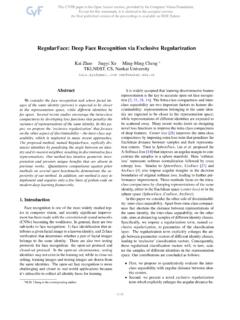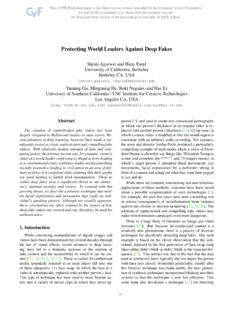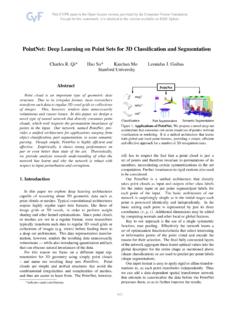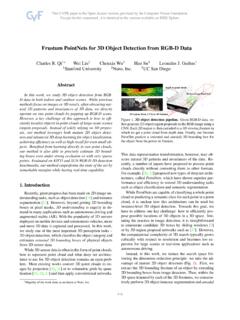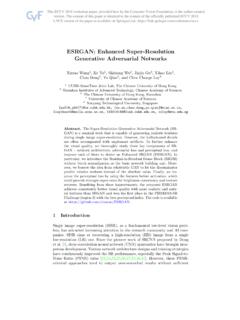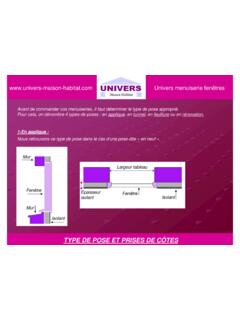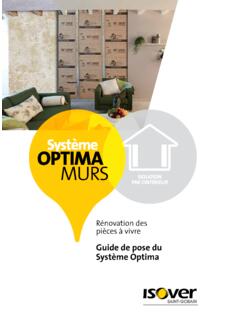Transcription of A Simple yet Effective Baseline for 3D Human Pose Estimation
1 A Simple yet Effective Baseline for 3d Human pose estimationJulieta Martinez1, Rayat Hossain1, Javier Romero2, and James J. Little11 University of British Columbia, Vancouver, Canada2 Body Labs Inc., New York, the success of deep convolutional networks,state-of-the-art methods for 3d Human pose Estimation havefocused on deep end-to-end systems that predict 3d jointlocations given raw image pixels. Despite their excellentperformance, it is often not easy to understand whethertheir remaining error stems from a limited 2d pose (visual)understanding, or from a failure to map 2d poses into 3-dimensional the goal of understanding these sources of error,we set out to build a system that given 2d joint locationspredicts 3d positions.
2 Much to our surprise, we have foundthat, with current technology, lifting ground truth 2d jointlocations to 3d space is a task that can be solved with aremarkably low error rate: a relatively Simple deep feed-forward network outperforms the best reported result byabout 30% on , the largest publicly available3d pose Estimation benchmark. Furthermore, training oursystem on the output of an off-the-shelf state-of-the-art 2ddetector ( , using images as input) yields state of the artresults this includes an array of systems that have beentrained end-to-end specifically for this task.
3 Our results in-dicate that a large portion of the error of modern deep 3dpose Estimation systems stems from their visual analysis,and suggests directions to further advance the state of theart in 3d Human pose IntroductionThe vast majority of existing depictions of humans aretwo dimensional, video footage, images or representations have traditionally played an impor-tant role in conveying facts, ideas and feelings to other peo-ple, and this way of transmitting information has only beenpossible thanks to the ability of humans to understand com-plex spatial arrangements in the presence of depth ambi-guities.
4 For a large number of applications, including vir-tual and augmented reality, apparel size Estimation or evenautonomous driving, giving this spatial reasoning power tomachines is crucial. In this paper, we will focus on a partic-ular instance of this spatial reasoning problem: 3d humanpose Estimation from a single formally, given an image a 2-dimensional rep-resentation of a Human being, 3d pose Estimation is thetask of producing a 3-dimensional figure that matches thespatial position of the depicted person. In order to go froman image to a 3d pose , an algorithm has to be invariant toa number of factors, including background scenes, lighting,clothing shape and texture, skin color and image imperfec-tions, among others.
5 Early methods achieved this invariancethrough features such as silhouettes [1], shape context [28],SIFT descriptors [6] or edge direction histograms [40].While data-hungry deep learning systems currently outper-form approaches based on Human -engineered features ontasks such as 2d pose Estimation (which also require theseinvariances), the lack of 3d ground truth posture data for im-ages in the wild makes the task of inferring 3d poses directlyfrom colour images , some systems have explored the possibility ofdirectly inferring 3d poses from images with end-to-enddeep architectures [33,45], and other systems argue that 3dreasoning from colour images can be achieved by trainingon synthetic data [38,48].
6 In this paper, we explore thepower of decoupling 3d pose Estimation into the well stud-ied problems of 2d pose Estimation [30,50], and 3d poseestimation from 2d joint detections, focusing on the pose Estimation into these two problems givesus the possibility of exploiting existing 2d pose estimationsystems, which already provide invariance to the previouslymentioned factors. Moreover, we can train data-hungry al-gorithms for the 2d-to-3d problem with large amounts of3d mocap data captured in controlled environments, whileworking with low-dimensional representations that scalewell with large amounts of main contribution to this problem is the design andanalysis of a neural network that performs slightly betterthan state-of-the-art systems (increasing its margin when12640the detections are fine-tuned, or ground truth)
7 And is fast (aforward pass takes around3ms on a batch of size 64, allow-ing us to process as many as300fps in batch mode), whilebeing easy to understand and reproduce. The main reasonfor this leap in accuracy and performance is a set of simpleideas, such as estimating 3d joints in the camera coordinateframe, adding residual connections and using batch normal-ization. These ideas could be rapidly tested along with otherunsuccessful ones ( estimating joint angles) due to thesimplicity of the experiments show that inferring 3d joints fromgroundtruth 2d projections can be solved with a surprisinglylow error rate 30% lower than state of the art on thelargest existing 3d pose dataset.
8 Furthermore, training oursystem on noisy outputs from a recent 2d keypoint detec-tor yields results that slightly outperform the state-of-the-arton 3d Human pose Estimation , which comes from systemstrained end-to-end from raw work considerably improves upon the previous best2d-to-3d pose Estimation result using noise-free 2d detec-tions in , while also using a simpler archi-tecture. This shows that lifting 2d poses is, although farfrom solved, an easier task than previously thought. Sinceour work also achieves state-of-the-art results starting fromthe output of an off-the-shelf 2d detector, it also suggeststhat current systems could be further improved by focus-ing on the visual parsing of Human bodies in 2d , we provide and release a high-performance, yetlightweight and easy-to-reproduce Baseline that sets a newbar for future work in this task.
9 Our code is publicly avail-able Previous workDepth from imagesThe perception of depth from purely2d stimuli is a classic problem that has captivated the atten-tion of scientists and artists at least since the Renaissance,when Brunelleschi used the mathematical concept of per-spective to convey a sense of space in his paintings of Flo-rentine later, similar perspective cues have been ex-ploited in computer vision to infer lengths, areas and dis-tance ratios in arbitrary scenes [57]. Apart from perspectiveinformation, classic computer vision systems have tried touse other cues like shading [53] or texture [25] to recoverdepth from a single image.
10 Modern systems [12,26,34,39]typically approach this problem from a supervised learningperspective, letting the system infer which image featuresare most discriminative for depth 3d reasoningOne of the first algorithms fordepth Estimation took a different approach: exploiting theknown 3d structure of the objects in the scene [37]. It hasbeen shown that this top-down information is also used byhumans when perceiving Human motion abstracted into aset of sparse point projections [8]. The idea of reasoningabout 3d Human posture from a minimal representation suchas sparse 2d projections, abstracting away other potentiallyricher image cues, has inspired the problem of 3d pose esti-mation from 2d joints that we are addressing in this to 3d jointsThe problem of inferring 3d joints fromtheir 2d projections can be traced back to the classic workof Lee and Chen [23].
